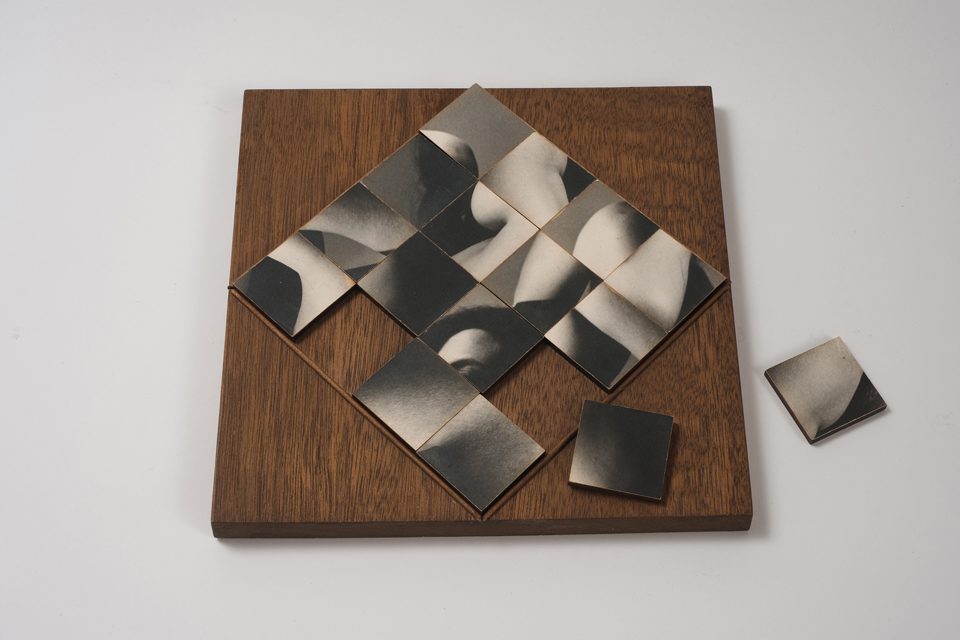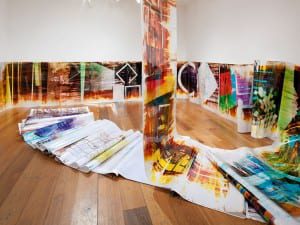A retrospective of Robert Heinecken at The Museum of Modern Art explores an artist whose work questions and subverts the imagery associated with popular media.
From magazines, newspapers and television to pornography and home photography, the art of Robert Heinecken (1931-2006) is both a celebration and a critique of dissemination of the photographic image across culture. In Robert Heinecken: Object Matter, a retrospective show curated by Eva Respini, the Museum of Modern Art in New York surveys the career of this influential artist whose work is heavily invested in and also sits alongside the medium of photography. As the first major exhibition to span Heinecken’s career since his death, the presentation reveals an artist whose work was a precursor to many techniques that define contemporary art practice.
While not perhaps as well known to the public as artists, such as, Barbara Kruger, John Baldessari and Ed Ruscha, Heinecken’s work was fundamental to the conceptual critique of American popular culture in the 1960s and 1970s. His style developed during the golden age of print culture, when visuals in magazines were the fundamental way in which photography was experienced at the time. Indeed, incorporating text into his art and critiquing popular media from within by employing similar devices are hallmarks of Heinecken’s often unsettling reimagining of the photograph. However, as Respini notes, Heinecken’s work also looks forward to contemporary practices and his diverse oeuvre is particularly relevant to the current proliferation and availability of images through the internet by way of social media, etc. She says: “Heinecken is an artist who is very much of his time – the 1960s and 1970s but also very much of our time. Looking at the work, it feels contemporary in the way he freely uses images that are already out there in the world, from magazines, television, newspapers and the world at large. The way that he recontextualises, reuses and recycles the same image sources in his works is utterly like art today. That’s how artists create today, and also to a certain extent how we live our lives, with Google Image Search and with the fluidity of pictures both digital and on the printed page.”
His seminal series Are you Rea (1964-68) features a sequence of photograms created from fragments of magazine pages. The mirroring of the letters in the title, which comes from one of the works, is an indication of the reflexive and reflective strategy employed by Heinecken across the piece. He is interested in the ways in which the imagery in cultures reflects and manufactures our psychological states and he is interested in skewing and refracting that through the techniques of collage, fracture and cut-up. Inverted text and reversed images give the photograms in Are you Rea a ghostly and spectral quality as almost the underside of the pristine magazine depictions of life in an increasingly commercialised American culture of the 1960s. Taken from publications such as LIFE, TIME and Women’s Day, these collages and cut-ups explore the breadth of popular media through a technique that has its basis in the art of juxtaposition, such as combining pictures of John F. Kennedy with an advertisement for carpets. In many cases, however, this is a “found” juxtaposition, created by superimposing opposing pages on top of each other. This work therefore displays a subtle understanding of the thought-processes behind magazine manufacture. Heinecken’s work, which may at first seem absurd, in fact makes us question the thought-processes behind capitalism and commercialisation where situating a carpet advert next to an article on John F. Kennedy might be seen to be a desirable position for the carpet manufacturer.
In a long career, Heinecken traversed many different forms and media, while always being related to the activity of photography. The founder of the dedicated photography programme at UCLA and a teacher on the course until 1991, he was heavily involved in the activity of photography and highly knowledgeable about its history and development. His experiments across different media were always, in one way or another, related to camera work. One of his most notable achievements is the expansion of the medium of photography to incorporate photography-based paintings, collages, printmaking, Fluxus-style interventions, installations, film and other practices. It is in this sense that Heinecken described himself as a para-photographer, as Respini explains: “He likened his work to a paralegal or a paramedic in the sense that his work stood beside traditional ideas associated with photography. So, while he dealt with photographic ideas, the way in which he executed them was untraditional.”
In this way, Heinecken’s work was directly antithetical, and indeed antidotal, to “fine art photography” as it was often understood at the time. Based in California, his work can be seen in direct contrast to the romantic images of Ansel Adams and Edward Weston. Whereas these artists sought to define and reflect the American landscape, Heinecken’s work is concerned with depicting the psychological experience of images within the American media-scape. His work has a distinctively subversive and dangerous atmosphere, while also dealing with themes of kitsch and sexuality head-on.
One way in which these themes are dealt with in Heinecken’s work is through the frequency with which he employs images of the female nude. As Respini comments: “The female nude is a leitmotif for Heinecken starting in the early 1960s and used throughout his career.” In works such as Transitional Figure Sculpture (1965), Heinecken was interested in the ways in which viewer interaction can create a photographic sculpture or photo-object that alters each time it is experienced. A 26-layer octagon of photographs of a female nude, this piece can be reconstituted by the viewer to compose a conventional unclothed subject or can be fractured in diverse ways to produce a photo-object that is puzzling. In Fractured Figure Sections (1967), Heinecken uses visuals from a bare model that resist recombination into a total entity; the view of the nude is always partial, clipped or abridged.
With its frequent use of shots from pornography and recurrent motif of the female nude, in the 1970s Heinecken’s art was regarded as extremely controversial. He came under attack from the feminist movement as exemplifying theories of the gender asymmetry in portrayal of men and women in media and culture, such as Laura Mulvey’s influential critique of “the male gaze” in film. As Eva Respini remarks, this aspect of Heinecken’s style is complex. There is a strong sense in which his work can be read as a social critique of the way sexuality is employed in American culture to “practically sell anything.” Heinecken was also interested in the relationship between sex and violence as represented in American culture, particularly in the 1960s and 1970s with the Vietnam War and significant social unrest. His use of pornographic photographs and shots from fashion magazines, for example, was employed to critique a media culture in which horrific images of violence from the Vietnam War were displayed alongside pictures from advertising, fashion and lifestyle press. His interest in this area is primarily in juxtaposition, the comparison of violent and sexualised imagery.
There is a great humour to many of Heinecken’s pieces, and he is able to raise issues concerned with popular media in a way that is comical. The work Kodak Safety Film / Christmas Mistake (1971), for example, features pornographic photos superimposed onto a photographic portrait of his own children at Christmas, creating the illusion that there has been a mix-up during processing. Offering a critique of the way youngsters are exposed to sexualised culture and the double standards of parents who try to protect them from it, this piece is also a light-hearted commentary on the processes involved in analogue photography, not least the illusionistic quality of this piece, where his title suggests a narrative that is of course an artistic device.
Alongside the element of social critique there is also a disconcerting and complicated celebration of erotic depictions of women. By today’s standards, the sexualised visuals that appear in Heinecken’s work are relatively tame; however, it does make for an at times uncomfortably direct treatment of provocative photography in which the elements of social critique and genuine celebration of the images are difficult to separate. In this sense, Heinecken’s work can be regarded as an unflinching exploration of his own fascination with the erotic in a way that demonstrated an awareness of how this was influenced and channelled by the media culture in which he lived. Fundamentally, Heinecken reveals the ways in which all our gazes are fabricated by the media that we are constantly exposed to.
Heinecken’s interest in the photographic form went beyond the shot itself and in particular he was intrigued by how photographs are disseminated and manufactured within the culture. In 1969 he dismantled copies of TIME magazine and printed pornographic images from the pornographic magazine Cavalcade on every page before reassembling the issues and disseminating them through doctors’ and dentists’ waiting rooms or by slipping them covertly into news stands. These interventions suggest a “paratrooper” aspect to this para-photographer’s practice, an artist who is interested in reconstituting the ways in which photographic work is experienced in culture through direct intervention. In 1989 Heinecken employed a similar strategy in 150 Years of Photojournalism in which he amended a special edition of TIME in compelling ways running the text from neighbouring pages into one another, and cutting up iconic pictures. As was the case 20 years earlier, this piece disrupts expectations and critiques the single narrative of photojournalism. On the front page, for example, is pasted the deliciously wry observation that “The single advertiser is Kodak.”
In the 1970s and 1980s, Heinecken turned his attention to the television culture, which had superseded the magazine as the dominant way in which imagery was experienced by society in America. His piece TV / Time Environment (1970) involves a positive transparency of a female nude placed in front of a functioning TV set. This installation is one of the first works in which Heinecken explored television and also his first large-scale sculptural installation. Set within a domestic setting, the piece fully articulates the ways in which televisual images are at the heart of our everyday lives, quite literally persuading us and selling us things from our own living rooms, often using the power of sex. As his title suggests, Heinecken’s focus in this work is on the environment in which TV reaches the viewer and the impressions that this has on them. The technique involved in this art makes use of chance juxtaposition by allowing the viewer to see whatever is streaming on television through the transparency of the female nude.
Also concerned with televisual culture, his work Inaugural Excerpt Videograms (1981), is a composite from Ronald Reagan’s inaugural presidential speech, which was broadcast live on television in full. Given his former career as an actor, Reagan is a particularly appropriate target for a work that critiques the real and unreal in imagery related to contemporary culture. Arranged in a grid and made by placing photographic printing paper directly on a television screen, attention is focused on the ways in which power politics play out within homes all over through the medium of television. Free of sexualised imagery, this is one of the most sober and sobering of Heinecken’s works, paring back some of the more overt kitsch that defines his practice and replacing it with perhaps the ultimate kitsch of the rigmarole associated with democratic power and process. These works reveal an artist remarkably attuned to developments in media and popular culture. As Respini comments: “It is hard to imagine otherwise than that if Heinecken were alive today, the media he would be exploring through his photographic work would naturally be the internet. However, in his tireless explorations of media and popular culture, his art presages such a critique.”
Robert Heinecken: Object Matter runs until 7 September at the Museum of Modern Art in New York. For further information visit www.moma.org.
Colin Herd





